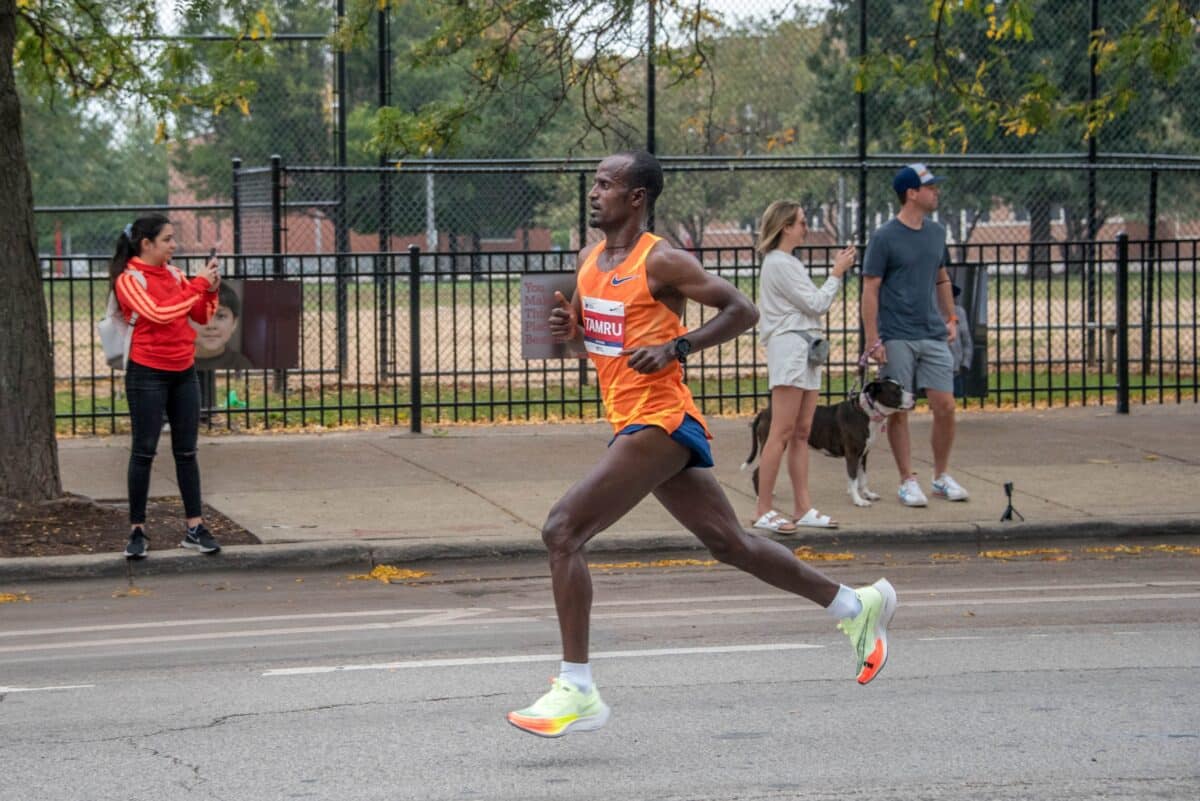Endurance in the long haul: over weeks to months, daily energy burn trends toward a common ceiling— even for elites. (Credit: Louis Dty on Shutterstock)
In A Nutshell
- Over weeks to months, even elite athletes settle near about 2.5× their resting metabolism. That is the body’s practical “speed limit.”
- Short bursts can soar much higher, but they fade fast. Big peaks are not sustainable for long stretches.
- When training gets extreme, almost all extra energy goes to the sport itself. Everyday functions slow down and you cannot simply “out-eat” the limit.
- Rare outliers might go above the ceiling, yet the average trend holds steady across athletes and events.
NORTH ADAMS, Mass. — For an entire year, researchers followed 14 of the world’s most extreme endurance athletes, measuring every calorie they burned during brutal competitions and punishing training schedules. What they found: humans have a metabolic ceiling that even the fittest bodies on Earth cannot break.
Their study, published in Current Biology, provides the first doubly labeled water measurements spanning up to 52 weeks in a cohort of elite ultra-endurance athletes. Athletes who routinely covered thousands of kilometers in ultramarathons, multi-day cycling events, and Ironman triathlons all hit the same wall. Over weeks and months, the group average never exceeded 2.5 times resting metabolism.
Lead author Andrew Best of Massachusetts College of Liberal Arts recruited athletes who regularly push human endurance to its limits. If anyone could break through metabolic ceilings, these athletes would. Yet the data revealed consistent boundaries across the group.
Tracking Energy Expenditure in Elite Athletes
Best and colleagues from Duke University recruited 12 male and two female ultra-endurance athletes, averaging 37 years old, all ranked as highly trained, elite, or world-class competitors. Ultramarathon runners in the group logged an average of 6,533 kilometers over the study period. The cyclists and triathletes trained an average of 993 hours, with some exceeding 1,000 hours.
Scientists used doubly labeled water, a gold-standard technique that tracks special isotopes in the body to calculate precise energy expenditure. Athletes drank doses of labeled water before competitions and training blocks, then provided urine samples over the following days or weeks. Laboratory analysis revealed exactly how many calories their bodies burned.
Athletes also kept detailed training logs on platforms like Strava, recording every run, ride, and workout. Direct measurements combined with training data allowed researchers to reconstruct rolling energy expenditure estimates from single weeks up to 52 weeks.
Researchers calculated “metabolic scope” for each athlete: the ratio of total daily calories burned to basal metabolic rate, the energy needed just to keep basic body functions running. A metabolic scope of 3.0 means total energy expenditure is three times basal metabolic rate.
Endurance in the long haul: over weeks to months, daily energy burn trends toward a common ceiling— even for elites. (Credit: Louis Dty on Shutterstock)
Why Maximum Daily Calorie Burn Drops as Exercise Duration Increases
During brief, intense efforts, athletes hit remarkable peaks. One runner reached 7.08 times his basal metabolic rate during a 23.5-hour maximum effort on the Appalachian Trail. Several runners sustained scopes above 4.0 during multi-day ultramarathons stretching five to 13 days.
As duration extended, maximum sustainable energy expenditure fell predictably. At one week, athletes averaged 3.75 times resting metabolism. By 12 weeks, that dropped to 2.57. At 30 weeks, the group mean reached 2.43 times basal metabolic rate, or roughly 4,085 calories per day. The 52-week average settled at 2.39.
Four athletes did push beyond 2.5 times resting metabolism at longer durations, with the highest reaching 2.74 over 30 weeks. Yet the group average stayed below the threshold, matching earlier predictions by Herman Pontzer and colleagues who analyzed multiple endurance studies and proposed a duration-dependent metabolic ceiling.
Plotted on a graph, the data traced a logarithmic decline predicted by earlier work from Thurber and colleagues. Maximum energy output dropped from around 10 times basal metabolic rate for day-long events, leveling off near 2.5 times resting metabolism at approximately 28 weeks. Every athlete in the study conformed to this pattern during races, and ten remained below this threshold throughout their full year of training.
What Happens to Your Body When Exercise Demands Are Extreme
Best’s team modeled how runners allocated energy during different training intensities. They divided daily calorie burn into three parts: basal metabolic rate, digestion, and activity energy expenditure. Then they separated running costs from everything else.
During light training weeks when runners covered 17 kilometers per day, they burned roughly 920 extra calories beyond what running alone required. That energy likely fueled normal daily activities, non-running workouts, and physiological processes like tissue repair and immune function.
During races at 118 kilometers per day, that extra expenditure vanished. Virtually all energy above resting metabolism went to running. Non-running activity energy expenditure dropped to near zero.
Athletes seem to shut down other activities when exercise demands are extreme. Earlier studies support this pattern. Research on ultramarathon runners found testosterone levels dropped during races, suggesting the body dials back reproductive processes when energy is scarce. Scientists have also documented changes in immune function during extreme endurance events.
The metabolic ceiling stems from multiple bottlenecks. The digestive system can only absorb nutrients so fast, even when athletes consume thousands of calories. During prolonged extreme exercise, the gut’s ability to process food probably becomes a constraint (what researchers call the “alimentary limit”).
The body also faces tradeoffs. Maintaining high energy output requires simultaneously processing massive food intake, repairing tissue damage, regulating temperature, fighting infections, and handling hundreds of other physiological tasks. Beyond certain intensities and durations, the system can’t keep up.
Some ultra-endurance feats hint at rare exceptions. Australian Pat Farmer ran around the continent in 1999, covering 14,964 kilometers over 195 days. Measurements from the third and fourth weeks showed him burning nearly four times his resting rate. If sustained, that would be 57% above the predicted ceiling for that duration.
French runner Serge Girard covered 27,011 kilometers in one year, averaging 74 kilometers daily. Applying the relationship between running distance and energy expenditure from the current study predicts he sustained 4.23 times his basal metabolic rate, which would be 69% above the proposed limit.
However, these estimates rely on assumptions about gait and don’t account for metabolic adaptation, which can reduce energy expenditure during extremely long events. Without direct measurements throughout these efforts, whether they truly exceeded the metabolic ceiling remains uncertain.
Within the study cohort, athletes had settled into a sustainable rhythm by 52 weeks, with energy expenditure essentially stable compared to 30-week levels. A small but detectable decrease occurred from 30 to 52 weeks within individuals, possibly reflecting seasonal variations or gradual adaptation to training loads.
Shifera Tamru Aredo running the Chicago Marathon in 2021. The study mapped how, over weeks and months, even elite endurance athletes approach a similar metabolic limit. (Credit: ChicagoPhotographer on Shutterstock)
Beyond Professional Sports
Understanding metabolic limits matters beyond elite athletics. Manual laborers, military personnel, firefighters, and others in physically demanding jobs face similar constraints. The study also illuminates human evolution: our ancestors survived by balancing energy from hunting and gathering against metabolic costs of those activities plus reproduction, growth, and immune defense.
The research carries limitations. Scientists relied on linear regressions from high- and low-mileage periods to reconstruct energy expenditure across the full year, assuming a constant relationship between training volume and calorie burn. In reality, factors like terrain, running versus walking, and exercise intensity create variability. The study also lacked data on body mass changes and detailed training intensity metrics.
But the core finding holds: detailed tracking showed elite endurance athletes consistently operate within a duration-dependent metabolic ceiling. The human body enforces an energy budget it refuses to exceed, regardless of fitness level or competitive drive.
Disclaimer: This article is for general informational purposes only and is not intended as professional medical, training, or nutritional advice. Consult with qualified professionals before making decisions about your health or training regimen.
Paper Summary
Methodology
Researchers recruited 14 ultra-endurance athletes (12 males, 2 females, average age 37 years) classified as highly trained, elite, or world-class competitors. The sample included 10 ultramarathon runners, one ultra-cyclist, one Ironman triathlete, and two multisport athletes. Scientists measured total energy expenditure using the doubly labeled water method, which involves athletes drinking water enriched with stable isotopes of hydrogen and oxygen, then providing urine samples over periods ranging from several days to two weeks. Laboratory analysis tracked how quickly the body eliminated these isotopes, allowing precise calculation of carbon dioxide production and total daily calorie burn. Athletes also maintained detailed training logs throughout a 52-week period, recording distance, duration, and type of exercise. For athletes with multiple measurements at varying training intensities, researchers developed individualized regression equations relating training volume to metabolic scope (the ratio of total daily energy expenditure to basal metabolic rate). These equations were applied to training records to estimate maximum metabolic scope over rolling periods of 1, 3, 6, 12, 30, and 52 weeks. For athletes with insufficient measurements for individualized equations, researchers used group-average relationships between training volume and metabolic scope.
Results
Maximum metabolic scope decreased predictably with event duration. During ultra-endurance competitions lasting approximately 24 hours to 13 days, athletes reached metabolic scopes as high as 7.08, with several maintaining scopes above 4.0 during multi-day races. As duration extended, maximum sustainable metabolic scope fell. Athletes averaged 3.75 times basal metabolic rate over one-week periods, dropping to 2.57 at 12 weeks. At 30 weeks, the cohort mean reached 2.43 times basal metabolic rate (approximately 4,085 calories per day), and the 52-week average settled at 2.39 times basal metabolic rate (approximately 4,020 calories per day). Four individual athletes exceeded 2.5 times basal metabolic rate at 30 and 52 weeks, with the highest reaching 2.74, but the group average remained below the proposed metabolic ceiling of 2.5 times basal metabolic rate for durations of 28 weeks or longer. Maximum metabolic scope fit a logarithmic regression declining from approximately 10 times basal metabolic rate at 24 hours to an asymptote near 2.5 times basal metabolic rate at roughly 28 weeks. Energy allocation modeling for ultramarathon runners showed that during light training weeks (averaging 17 kilometers per day), athletes expended approximately 920 calories per day on activities beyond running. During races (averaging 118 kilometers per day), this non-running activity energy expenditure dropped to near zero, with virtually all energy above resting metabolism allocated to running.
Limitations
The study relied on linear regression equations derived from high- and low-workload measurement periods to reconstruct metabolic scope across the full year. This approach assumes a constant relationship between training volume and energy expenditure, but, in reality, factors like terrain type, walking versus running gait, exercise intensity, and other unmeasured activities create variability. The research lacked data on body mass changes throughout the year, which would indicate whether athletes maintained energy balance. The study also did not measure maximal oxygen uptake or capture detailed training intensity metrics beyond volume. For five athletes, researchers used group-average regressions rather than individualized equations due to insufficient measurement periods or inadequate variation in training intensity between measurements. Energy allocation modeling for runners assumed a constant cost of transport equivalent to running on level ground, which may overestimate or underestimate actual expenditure depending on terrain and gait. The sample size was relatively small, particularly for non-running athletes, limiting generalizability. Without direct measurements during exceptional performances like Pat Farmer’s circumnavigation of Australia or Serge Girard’s year-long world record, the study cannot definitively confirm whether rare individuals can exceed the proposed metabolic ceiling for extended periods.
Funding and Disclosures
Funding was provided by Duke University and a Massachusetts College of Liberal Arts Faculty Incentive Award. The authors declared no competing interests.
Publication Information
Best, A., Sadhir, S., Hyatt, E., & Pontzer, H. (2025). “Ultra-endurance athletes and the metabolic ceiling,” published October 20, 2025. in Current Biology, 35, 5106-5110. doi:10.1016/j.cub.2025.08.063.


